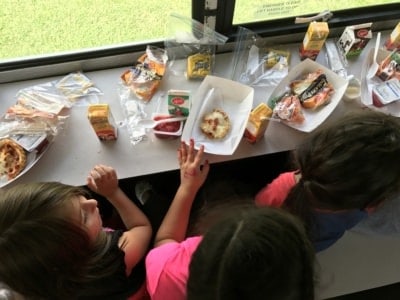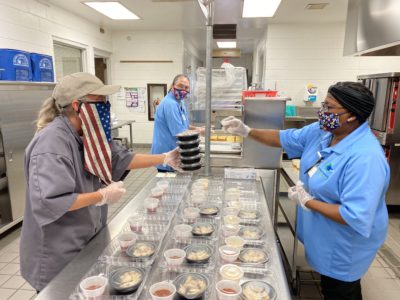
As students return to school in Jackson County, they will all receive school breakfast and school lunch at no cost. Now in its second consecutive year of operation, these no-cost meals are funded by the Jackson County Board of Commissioners, which provided more than $500,000 last school year to ensure all students could eat for free.
“When our students and families don’t have to worry about where their next meal is coming from, they’re free to focus on learning, growing, and thriving,” said Superintendent Dr. Dana Ayers in a press release. “We’re so thankful for our partnership with the Board of Commissioners and their continued investment in the well-being of our students.”
Laura Cabe, school nutrition director for Jackson County Public Schools, said she and other district leaders first started to imagine how to offer no-cost meals to all students in 2022 after the federal pandemic-era waivers that provided free meals to all students expired.
“Especially being a rural area here, there were so many things still going on and affecting families,” said Cabe. “That was the last thing I felt like people needed to worry about coming back to school and getting in a routine.”
![]() Sign up for the EdWeekly, a Friday roundup of the most important education news of the week.
Sign up for the EdWeekly, a Friday roundup of the most important education news of the week.
Cabe credits the leadership of Ayers and the collaboration of many other key stakeholders across the district — including principals, child nutrition staff, the district’s finance officer, and the school board — for figuring out what it would take to provide no-cost meals to all students and successfully advocating for it.
“We provide books, we provide transportation — food service should be one of those things,” she said.
Although all Jackson County Public Schools participate in the Community Eligibility Provision (CEP), which allows high-poverty schools and districts to offer breakfast and lunch at no charge to all students, federal reimbursements still left the district short of thousands of dollars needed to serve meals to all students for free.
The district had to consider not only the cost of food, but also the cost of salaries and benefits for staff, upgrading or maintaining old equipment, and ensuring adequate food storage. Cabe remembers it feeling like a “gut punch” when she realized that they did not have enough funds to offer free meals to all students under CEP.
Ultimately, district staff determined that, after accounting for existing reimbursements, it would cost roughly $500,000 to offer no-cost school meals to all students in the 2024-25 school year. Cabe said they estimate it will cost roughly $700,000 in the 2025-26 school year.
Ayers brought this estimate to the Jackson County Board of Commissioners, which committed to fund the program. The board is also supporting a range of other investments in the school district, including construction of the district’s first traditional middle school and upgrades to one school’s kitchen and cafeteria facilities.
School Meals 101


Three early impacts of free meals for all students
After serving no-cost school meals to all students in the 2024-25 school year, Cabe has already seen the impact the program is making.
1. Increased participation in school meals
Research points to numerous benefits of participating in school meals, including their role in alleviating food insecurity, supporting good nutrition, and increasing student achievement. According to Cabe, participation in school meals increased roughly 5% district-wide during the 2024-25 school year.
“We were happy with that — anywhere between 5% and 10% is what I was hoping would happen,” said Cabe.
This increase follows a trend seen in many of the nine states that are implementing no-cost meals for all statewide. In the four states that implemented no-cost meals for all in the 2023-24 school year — Colorado, Michigan, Minnesota, and New Mexico — there were increases in both breakfast participation (+27.2%) and lunch participation (+16%).
2. Eliminated school meal debt and reduced stigma for students
Prior to school meals being offered to all students for free, JCPS used an angel fund to provide meals to reduced- or full-price meal students who otherwise did not have the means to purchase a meal. Individuals and businesses could donate money to the fund, which then was used to cover school meal debt.
But Cabe remembers a time before the angel fund, when students who couldn’t afford to purchase a meal would only be offered an “alternative” meal of a cheese sandwich.
“You have this little child coming through, who has no money, and they don’t have a meal application,” said Cabe. “It is terrible, terrible, to try to even process having that child put (their meal) down and then you have to go get them a cheese sandwich.”
Now, with no-cost meals for all students, the angel fund is no longer needed, school meal debt is eliminated, and all students are served the same hot lunch each day.
“This is the biggest thing to me,” said Cabe. “We just don’t have to shame kids.”
3. Reduced administrative burden and increased morale for school nutrition staff
When pandemic-era waivers expired, school nutrition staff had to return to collecting applications for free and reduced-price meals. Cabe said she and her staff would dedicate significant time to processing applications and trying to contact students’ families who had not yet submitted an application, including sending letters and phone calls home.
“I even made appointments, and I’ve met people in their parks, or had people come with me in their homes to fill meal applications out before COVID,” said Cabe.
Her staff also spent time managing the angel fund, including working with school social workers and counselors to get in touch with families and process transactions back and forth between the fund and students’ school meal accounts.
Now, with no-cost school meals for all students, school nutrition staff no longer have these responsibilities.
“We can focus on feeding kids in our program, and that’s been wonderful,” said Cabe. “A lot of the burden was the paperwork, and that’s just relieved time and relieved heartache.”
For other local leaders considering investing in free school meals for all students, Cabe says there is nothing more valuable than seeing school meals in action.
“Visit your cafeteria, volunteer to serve meals, eat with your kids, or just come see what it’s all about,” said Cabe. “That is the best way to learn about what goes into it, and to understand the financial part.”
Recommended reading



